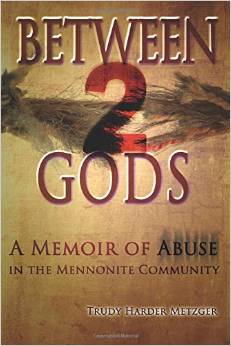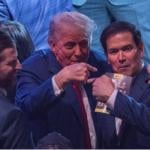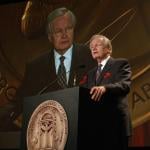The following is part of the Patheos book club for Living into Focus.
Living Into Focus: Choosing What Matters in an Age of Distraction by Arthur Boers, is a book that invites us into a journey of discovering what it means to be fully human. The author urges us to consider our usage of technology and how such use can deter us from truly focused lives. In this age of distraction, fueled by the age of technology, we’ve run around frivolously it trying to fill voids within our souls. The problem is that these sorts of voids can only be filled if we begin to remove to distraction and purse to focal priorities.
“When we allowing devices and machines to reside at the center of our lives, we displace values and practices that once enriched the quality of how we live. Which end up serving our gadgets instead of using them as tools to support our priorities. Technology itself becomes the center and purpose of how we live” (19).
Albert Borgmann is the source for our author’s philosophical perspective. For Borgmann, contemporary culture with its emphasis on both consumerism and technology, lead people down a path that actually deforms their human existence. Because of this, he names several ways in which technology subverts relationship and humanness. One of the most telling examples of this is the focal point of one’s home.
If you were like me, you’re living areas are most likely centered around the position of the television set. One thing that the author points out, is that such an orientation and once home can actually have an effect on the family dynamic. Television then, becomes the reason families gather in the living room. Instead, families ought to be gathering for times of conversation and shared experiences that offer opportunities for mutual involvement in activities beyond simply staring at a screen. This is one example of many.
Or think of communication devices in general. It seems that the more technology we have, the more busyness and clutter. In other words devices that are supposed to make communication easier actually creates a lack of focus and cultivates alienation in our relationships. Boers states:
Communication devices were supposed to bring us closer to family by allowing us to work at home; instead, they often detract from time and attention for spouses and children. Computers and cybercommunication we’re going to help us become paperless, but we consume growing quantities of paper. Machine screw quieter, but we use more of them and so add to the noise. Devices are increasingly energy efficient, but we employ so many of them we end up using more power than ever. Well computers and online connections get faster, the time we spent on them keeps going up. The better we are responding to email, the more we are inundated by it. Body gets easier to assemble meals and food becomes convenient, our society shows greater problems with obesity. People feel safer because of cell phones, but then, without much wilderness savvy and bolstered by an optimistic sense of connectedness afforded them by their cell phones, they end up taking needless risk (70).
Technology affects how we live and the kind of people that we become. That is expressed clearly in this book and argued in a nonjudgmental tone. This book is truly one that will help you live into focus.
Boers believes that we need to integrate practices and our lives that help us resist the techniques of technology to cultivate a fuller human experience, both relationally and personally. For some this will mean going on Heigts just for that your joy of it. Or perhaps a walk around the neighborhood, or walking to work instead of driving a car. Whatever makes someone feel alive without the need to make shortcuts, these are the sorts of activities that Boers invites us to reconsider.
In order to discern what a focal practice is, Boers offers three things from the work of Albert Borgmann.
1. The first characteristic of something that would be considered a focal practice is commanding presence. Page 26 this is a sort of activity that “Take energy and effort; they make demands on us. They can be tough task masters as they require discipline, attention, and focus, thus helping us grow in character they are beyond our control or our ability to manipulate or consume.” (see: 26)
2. “Focal practices and focal things affect us on various levels. They link us into a rich network of people and ecosystems.” One example of this might be eating local foods. When we think about what we eat we not only engage in community with those close to us, but we’re also thinking about how our choices affect the earth and systems. Local farmers markets and other sort of movements to eat locally and ethically are common examples of this. (see: 35)
3. The third quality of local realities is “that day have a centering or orienting power.” In other words these practices help us to relieve stress by focusing our attention on things that actually matter, and for Christians, Jesus is ultimately that center. These sort of practices leave people re-oriented on what it means to be fully human in God’s world. (see: 47)
In the final portion of this book, Boers offers some great advice. He says it’s helpful to move forward in these sorts of ways by understanding to sorts of decisions. The first of these are fundamental decisions. These are the broad choices that we make about our priorities of how we choose to live. The second, our daily decisions. These are the decisions that we make each and every day to live into the fundamental decisions of how our lives are to be shaped. As we navigate between these two sorts of decisions, our commitments will be placed higher than our brevity of time.
Unquestionably, changing our habits to reflect our big picture commitments will be difficult. One way to do dad is to make things that would distract us more difficult to access. For instance, if you have a TV remote. Get rid of it! That is a simple example, but you get gist. In other words, we need to raise the threshold of our casual use of technology. On the other side of this, we need to lower the threshold’s or make easier to access the kinds of things that help us prioritize. Maybe an example of this would be to get rid of the extra car, so that you are forced to think about other alternatives to get you and from places like work or school. In doing so, you create an opportunity to fully engage in a focal activity like walking.
Although my overview of this book may be quite inadequate, I do want to say that I highly recommend it. In our rushed world filled with technological distractions and easy outs, we need to slow down our pace and become the fully human image bears that God designed us to be. This book helps us to confront the ways in which distractions in our world need not hold us back from transforming into people who are fully devoted to God and fully satisfied. I hope you will take the time to read this book carefully and allow it to confront the dark areas of busyness and hopefully point us all towards living into focus.












